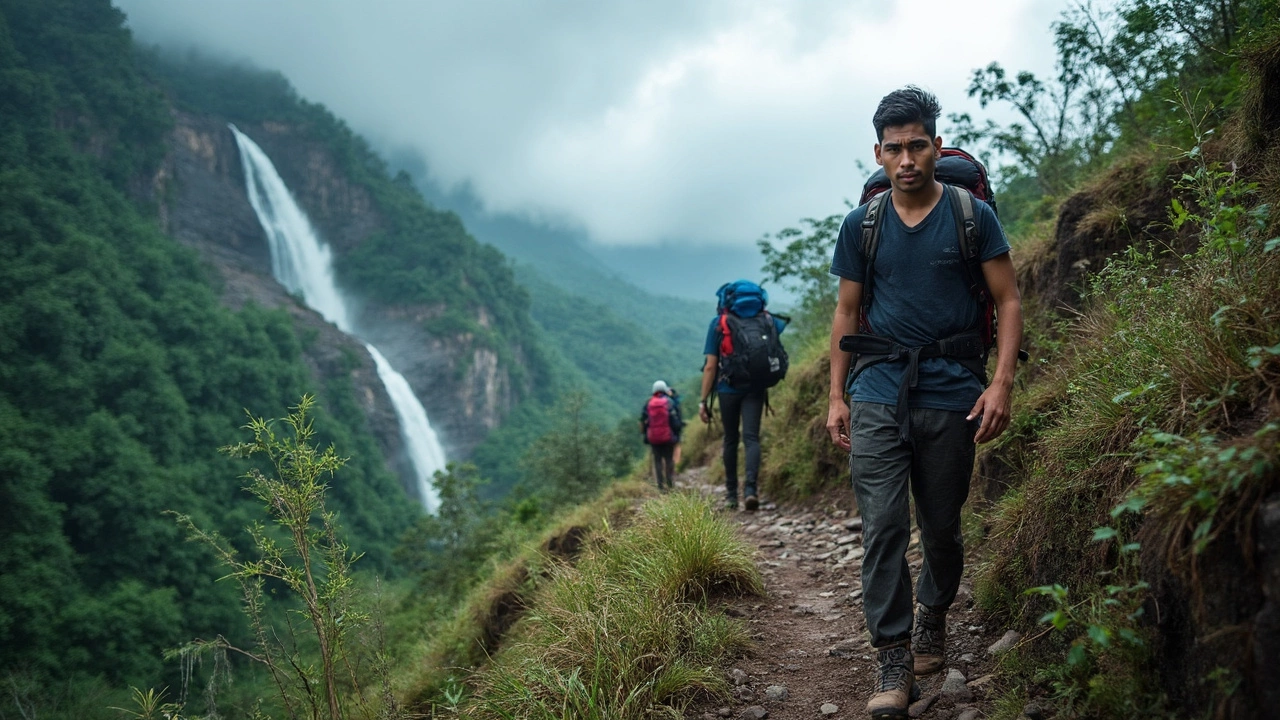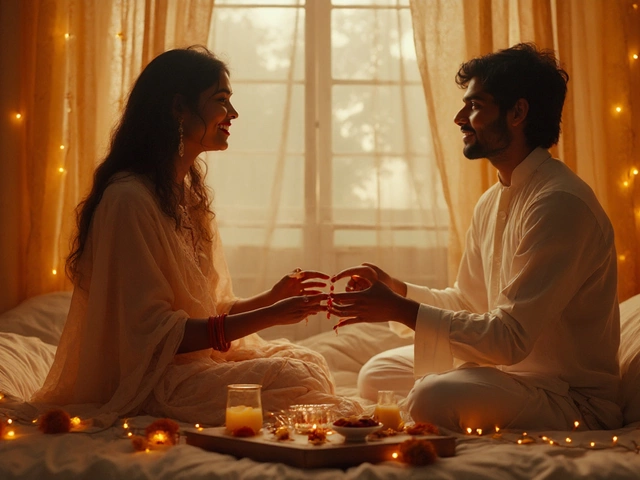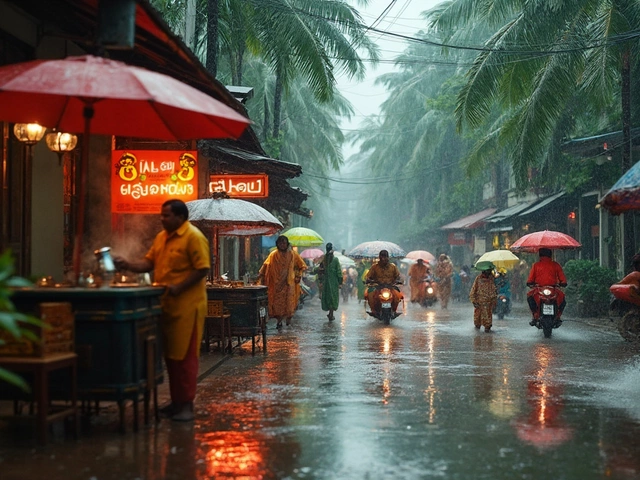So, you're curious about hiking and trekking, eh? It's easy to confuse the two, but the difference lies in the details. Hiking is generally a leisurely walk through nature on well-marked paths, often completed within a day. Trekking, on the other hand, is like watching the extended edition of a movie—it's a long journey, sometimes over rough terrain, and can stretch over multiple days.
Now, why does this matter? If you're gearing up for an adventure in amazing places like India, it helps to know what you're signing up for. Are you in for a short, lovely ramble through a national park, or are you ready for days of trekking in the Himalayas? Each has its own charm, but they require different levels of prep. Let’s dive into what makes these activities tick.
- Understanding Hiking
- Exploring Trekking
- Differences in Terrain
- Challenges and Preparation
- Top Trekking Spots in India
- Tips for Beginners
Understanding Hiking
Alright, let's break down hiking. It's one of the simplest ways to enjoy the great outdoors, and honestly, it's probably the most accessible form of outdoor adventure. Generally, hikes are done on well-marked trails that are manageable for most fitness levels. We're talking about routes that are much like a friendly nudge into nature.
Basics of Hiking
Most hikes are designed to be completed within a day and don't require a heavy pack. It's perfect if you want to escape the hustle and recharge without diving into a multi-day commitment. These trails are usually found close to urban areas — it's about stepping into a park, forest, or hilly area and just soaking in the landscape.
"Hiking has one of the lowest environmental impacts of any recreation activity," says Dr. Alice Maher, an environmental science researcher.
Health Benefits
Hiking isn't just about the views; it's a full-body workout. Walking on uneven paths can help build balance and strength, and it’s a good cardio workout too. Plus, being outside can improve your mental well-being. It's like therapy, except with trees.
Where to Hike
India's got some incredible spots for hiking. Take Lonavala's Rajmachi Fort in Maharashtra. It's a straightforward hike with terrific views, perfect for beginners. If you're near Delhi, the Aravalli Mountain Range is your go-to.
Hiking Essentials
While you don't need much to start, there are a few essentials. Here's a quick list:
- Comfortable Footwear: Invest in a pair of sturdy hiking boots or shoes.
- Water: Hydration is key. Carry enough water for your journey.
- Snacks: Bring some nuts or energy bars to keep your energy up.
- Map or GPS: Even familiar trails can get confusing.
At the end of the day, hiking is about enjoying the journey. It's finding peace in the rustle of leaves, the shades of green, and the chirping of birds. So, lace up your boots and hit the trail!
Exploring Trekking
Trekking is like hiking's adventurous big brother. It's not just about walking; it's about embracing the whole journey. Here’s the deal: when you go trekking, you're committing to a long-distance adventure where anything can happen.
Unlike hiking, which often fits into a day, trekking sprawls over several days and takes you through remote and rugged areas where the path isn't neatly laid out. Think dense forests, mountain ranges, and maybe even crossing a river or two.
Planning Your Trek
Because trekking is more involved, planning is key. You'll need to pack like a pro—think warm clothes for high altitudes and layers to handle the weather changes. A quality pair of trekking boots is a must; blisters are no one's friend.
- Always carry a reliable map or GPS, especially in places where signals drop.
- Water purification tablets can be lifesavers in areas with questionable water sources.
- Pace yourself, acclimate to altitude if you're heading to high places like the Himalayas.
Did you know that trekking in the Indian Himalayas offers incredible diversity? The Markha Valley trek in Ladakh, for instance, not only challenges you with high passes but rewards you with views of the breathtaking Stok Kangri.
Health and Fitness
Fitness is a biggie. Trekking isn't just physical; it's a mental game too. Prepare with cardio workouts and strength training exercises. The fitter you are, the more you'll enjoy the journey.
Embracing Nature and Culture
Trekking in India isn't just about the landscapes. It's an immersive dive into local cultures. Whether it's the vibrant traditions in Sikkim or the quiet villages of Himachal Pradesh, each trek unveils stories.
Lastly, always respect nature. Leave no trace, carry your litter back, and keep the trails pristine for others. Trekking is as much about personal achievement as it is about appreciating the earth.
Differences in Terrain
Once you get your head around what makes hiking different from trekking, it's all about the terrain. Think of hiking as a walk in the park, or rather a nature park. Trails are generally well-marked, with smooth paths that don't throw too many curveballs your way. Many popular spots for hiking in India, like the Kumaon Hills or the Nilgiris, offer terrific trails that won't ask for too much from your legs.
Now, let's wander over to the world of trekking. Here, paths can get rougher and less predictable. You could be climbing steep slopes or navigating rocky trails for days on end. Places like Ladakh or the Sikkim Himalayas are famous for this. Not only does the terrain challenge your stamina, but the weather can also be quite unpredictable.
Elevation Differences
Elevation is another key factor that separates the two. In hiking, you're usually sticking to lower altitudes. You know, less huffing and puffing. In contrast, trekking often takes you into higher elevations where the air gets thinner, and every step requires more effort and maybe a little more grit.
Path Maintenance
Hiking trails often enjoy regular maintenance, especially in areas popular with tourists. Markings, signs, and even shelters are part of the game. Trekking paths, however, might not get that luxury. In the wilderness of trekking spots in India, you might find yourself relying more on a map and compass than on conveniently placed signs, experiencing the raw beauty of untouched landscapes.
Whether you hit the hiking trails or opt for the more demanding trekking routes, the terrain you choose really shapes the experience you'll have. So, make sure to pick the right one for your adventure spirit!

Challenges and Preparation
Planning to explore the beautiful terrains of India through hiking or trekking? Well, each of these adventures poses different challenges, and being ready is half the battle.
Physical Fitness
If you’re opting for trekking, it's no walk in the park—literally! Treks in regions like the Himalayas demand a good fitness level. You might be climbing steep paths, so better start with some regular cardio exercise and strength training. On the other hand, hiking is more suited for casual adventurers, but don't underestimate your prep list either.
Gear and Equipment
Having the right gear is crucial. For both hiking and trekking in India, pack a backpack with essentials—water, snacks, a first-aid kit, and layered clothing. Trekking may require more advanced gear, like trekking poles, a sleeping bag, and sturdy boots. And trust me, comfy shoes make a world of difference.
Weather Conditions
Weather can be a wild card, especially in India. Places like Ladakh can be unpredictable—sunny at one moment and snowing the next. Before you set out, check the forecast and prepare for changes.
Navigating Routes
Hiking trails are often marked, but trekking paths might not be well-defined. Carry a reliable map or a GPS device. Getting lost isn't just stressful; it can be downright dangerous.
Altitude Sickness
Planning to trek in high places? Be cautious of altitude sickness. Acclimatize yourself properly by taking it slow, staying hydrated, and considering medications if you have a history of altitude issues.
Sample Checklist
- Water bottles or hydration bladders
- High-energy snacks
- First-aid kit
- Weather-appropriate clothing
- Map or GPS device
- Emergency contacts list
With these preparatory tips in mind, you're set to enjoy your hiking or trekking trip across India's stunning landscapes!
Top Trekking Spots in India
India is a treasure trove for trekking enthusiasts, with its vast landscapes offering everything from the snow-clad peaks of the Himalayas to the lush green forests in the south. Here are some of the best spots that should be on every trekker's bucket list.
Kedarkantha Trek
If you're a beginner looking to test the waters of trekking in India, the Kedarkantha Trek in Uttarakhand is a great start. It's famous for its astonishing campsites, with each clearing more beautiful than the last. Spanning about 20 kilometers and typically taking four days, it offers stunning views of the Himalayan peaks.
Valley of Flowers Trek
Ever dreamt of walking through fields of vibrant, blooming flowers? The Valley of Flowers in Uttarakhand is your chance. Recognized as a UNESCO World Heritage Site, this trail bursts with colors, especially during the monsoon season. The best time to visit is between July and September, when the valley is in full bloom.
Chadar Trek
Perhaps the most unconventional on this list is the Chadar Trek in Ladakh. Imagine walking on a frozen river! It’s a surreal experience, but definitely for the hardy trekkers, as it involves braving the harsh winter of January and February. Expect breathtaking landscapes in a realm of ice.
Roopkund Trek
Known for the mysterious 'Skeleton Lake' at the end of the journey, the Roopkund Trek offers an adventure mixed with intrigue. Located in Uttarakhand, this trek takes you through dense forests, adventurous ridges, and finally to the glacial lake studded with ancient skeletal remains.
Goechala Trek
Head over to Sikkim for one of the most picturesque treks that get you close to Kanchenjunga, the third highest mountain in the world. The trek offers jaw-dropping vistas of the Eastern Himalayas. It’s a bit on the tougher side but well worth the sweat and effort.
These trekking routes, accessible to most with a little preparation, provide an unbeatable way to experience India's natural beauty and cultural diversity. Whether you're hiking or embarking on an epic trekking adventure, India has more than its fair share of magnificent paths waiting for you.
Tips for Beginners
Starting your journey into trekking or hiking can feel like a mountain in itself, but don’t worry—it’s all about taking the first step. Let's get you on the right path with some practical advice to keep in mind.
1. Choose the Right Trail
Begin with trails that match your skill level. If you’re new, opt for popular hiking routes that are well-marked and less challenging. Once you're comfortable, consider exploring the more demanding trekking terrains of India like the Valley of Flowers. Always research trails before heading out and read reviews from other trekkers.
2. Pack Smart
Your backpack is your lifeline. Keep it light by packing essentials only. Think water, snacks, a first-aid kit, and a map. Don’t forget weather-appropriate clothing and a flashlight. Experienced trekkers in India swear by their trusty trekking poles.
3. Understand Your Fitness Level
Knowing your limits is key. Start small with local hikes to build stamina before tackling lengthy treks. Regular exercise like walking, jogging, or cycling can boost your endurance.
4. Stay Hydrated and Fueled
Dehydration can sneak up on you. Sip water regularly and have energy-boosting snacks on hand—nuts, dried fruits, and chocolate work wonders. Adjust your intake based on the climate, esp. in high-altitude trekking spots like in Ladakh.
5. Safety First
About 90% of rescue missions happen because people stray off the beaten path. Stick to marked trails and if you’re alone, tell someone your plans. Always follow signage and respect local guidelines.
6. Respect the Environment
The golden rule—leave no trace. That means no littering and minimizing your impact. Carry a bag to collect any trash and be respectful to wildlife. Many trekking areas in India like the Western Ghats are ecologically sensitive zones.
By taking these steps, your first venture into hiking or trekking should be both memorable and safe. Happy trails!



